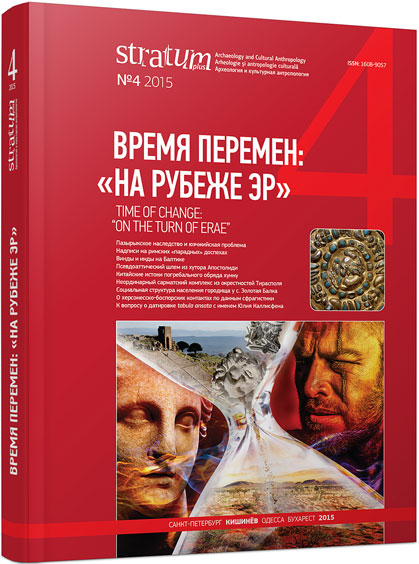К вопросу о датировке tabula ansata с именем Юлия Каллисфена
To a Question of Dating of tabula ansata with a Name of Julius Callisthenes
Author(s): Oleg V. Sharov, Mikhail M. ChorefSubject(s): History, Archaeology, Social history, Ancient World
Published by: Издательский дом Stratum, Университет «Высшая антропологическая школа»
Keywords: Bosporus; Kerch; Roman period; Epigraphy; Julius Callisthenes; stone crypt; Gold Headband plate
Summary/Abstract: The article studies a unique find for the Northern Black Sea — a gold forehead plate as a tabula ansata from the Crypt of Julius Callisthenes discovered on the northern slope of Mithridates Mount in Kerch in 1894. The plate was found on the head in the male burial, above the wreath, and is likely to be a central part of it. The study consisted of three phases: analysis of the grave goods buried in the crypt in the garden of stone, Abdul-Kerim, the establishment of their chronology; a thorough analysis of the paleographic inscriptions dating text; comparative analysis and synthesis of the results. As a result, these archaeological and paleographic analysis of the inscription on the forehead plate matched and pointed to the only possible date of the complex — second half of the second century AD. Thus, the inscription with a dedication to Julius Callisthenes is synchronous with armaments and horse equipment. This seems to be a burial of a noble warrior, perhaps a strategist in full gear, which is consistent with images of military ammunition on the Bosporan frescos from the Stasovsky Crypt in 1872.This artifact enables a better knowledge of the social structure of the Bosporus state and trace the organization and function of Thiasus. Paleographic analysis of the inscription makes it possible to develop methods for the study of the Bosporan inscriptions of the Roman time.
Journal: Stratum plus. Археология и культурная антропология
- Issue Year: 2015
- Issue No: 4
- Page Range: 357-375
- Page Count: 19
- Language: Russian
- Content File-PDF

